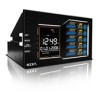- Qualcomm Launches Snapdragon 4 Gen 2 Mobile Platform
- AMD Launches Ryzen PRO 7000 Series Mobile & Desktop Platform
- Intel Launches Sleek Single-Slot Arc Pro A60 Workstation Graphics Card
- NVIDIA Announces Latest Ada Lovelace Additions: GeForce RTX 4060 Ti & RTX 4060
- Maxon Redshift With AMD Radeon GPU Rendering Support Now Available
NZXT Sentry LX Fan Controller

Whether you are looking to add some eye-candy to your machine, or want full control over your cooling system, adding in a robust fan controller isn’t a bad idea. One of the best we’ve seen to date is NZXT’s Sentry LX, which we happen to be taking a look at here. It’s well-priced, looks good and works well… three things we like to see with any product.
Page 2 – Installation and Testing, Final Thoughts
The installation was pretty simple enough. You have to have 2 free 5 ¼ drive bays and some simple patience to run a bunch of wires. The included tape will allow you to attach a thermal probe near every fan that you are running with the controller. Popping in the supplied battery will retain all your settings simply enough as well. The final connection is the 4-pin Molex power connector that powers the unit. Press your power button and away we go to setup.
Setup is a simple affair as well. Simply depress the “set†button and use the up/down arrows to change the current setting. Each press of this button will scroll you through each setting. No degree needed here to get it all going. Switching from manual to auto functionality takes is a snap as well. In manual mode you can use the “fan mode†button to scroll to each individual fan to alter the speeds to your desire. If you are unhappy with all your choices a quick press of the “reset “ button quickly brings you back to factory defaults.
The hardware used to test is as follows:
|
Component
|
Model
|
| Processor |
Intel Core 2 Extreme QX9650 – Quad-Core, 3.0GHz, 1.30v
|
| Motherboard |
ASUS P5Q PRO – P45-based
|
| Memory | |
| Graphics | |
| Audio |
On-Board Audio
|
| Storage |
Hitachi 160GB
|
| CPU Cooler | |
| Power Supply | |
| Chassis | |
| Et cetera |
For my testing I used a new program called OCCT 3.0. Not only does this simple program push the CPU to the brink of a meltdown through the use of LINPACK testing for Intel processors, it also turns up the juice on your GPU. It automatically maintains graphs of temperatures throughout your testing. I highly recommend you try it out on your own for your testing needs. I always run all my tests 3 times and take an average just to weed out any erroneous results. My ambient temperature is kept at a near constant 20°C year round as my test bed PC is in my basement. There are no fans or heat vents in the area of my test platform.
Testing was simple enough for the Sentry LX. Basically I ran my PC as normal with all fans 100% and achieved the expected results. Seeing how I just used this chassis for review, my results were in line with the results I got there. While I found no gains/losses running on the Auto mode, I also must state that the chassis selected along with the fans installed were no probably the highest load that the LX was designed to handle. Any way you look at it, this was an incredibly easy device to run and the price for admission makes it a very positive piece to have in your next build.
Any way you look at it, I feel that NZXT has a winner here. I confidently give it a solid 8 out of 10 rating. The build quality as well as functionality are there. Without a doubt the Sentry LX can be a very integral part of your next build especially if you are a die-hard air cooling aficionado that demands full control over your cooling needs.
- Pros
- Very well-priced.
- Simple to use.
- Straightforward installation.
- High-quality build.
- Cons
- Limited to 4W per fan channel.
- Awkward viewing angles.

Discuss this article in our forums!
Have a comment you wish to make on this article? Recommendations? Criticism? Feel free to head over to our related thread and put your words to our virtual paper! There is no requirement to register in order to respond to these threads, but it sure doesn’t hurt!
Support our efforts! With ad revenue at an all-time low for written websites, we're relying more than ever on reader support to help us continue putting so much effort into this type of content. You can support us by becoming a Patron, or by using our Amazon shopping affiliate links listed through our articles. Thanks for your support!





